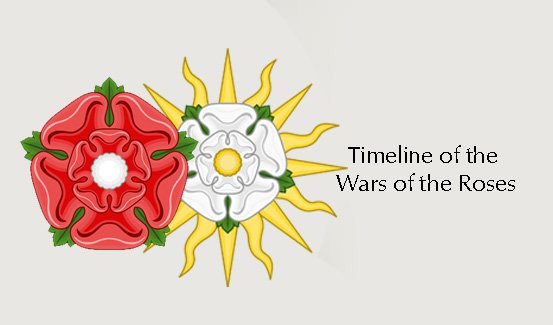Timeline of the Wars of the Roses
Welcome to our timeline of the Wars of the Roses.
The Wars of the Roses were a series of English civil wars fought between two rival branches of the royal family: the House of Lancaster, whose symbol was a red rose, and the House of York, whose symbol was a white rose. The wars took place between 1455 and 1487, and were named after the symbols of the two houses.
The roots of the conflict can be traced back to the reign of King Edward III, who had several sons, and his grandson, Richard II, who was deposed by his cousin, Henry Bolingbroke, in 1399. This led to the founding of the House of Lancaster, which held the English throne until 1461.
The House of York, on the other hand, was founded by Richard Plantagenet, Duke of York, who believed that he had a stronger claim to the throne than the Lancastrian King Henry VI. The Yorkists were able to briefly take control of the throne from 1461 to 1470, and again from 1471 until the end of the wars in 1487.
The Wars of the Roses were characterized by shifting alliances and numerous battles and skirmishes. The conflict was fueled by political and economic factors, as well as personal rivalries and ambitions of the various factions involved.
The wars came to an end in 1487 with the defeat of the Yorkist pretender, Lambert Simnel, at the Battle of Stoke Field. The Tudor dynasty, founded by Henry Tudor, who had a distant Lancastrian claim to the throne, emerged victorious and went on to rule England for over a century
-
1399: King Richard II is deposed by his cousin, Henry Bolingbroke, who becomes King Henry IV, founding the House of Lancaster.
-
1413: King Henry V succeeds his father, Henry IV, and launches a successful military campaign in France, which ends with the Treaty of Troyes, in which he is recognized as heir to the French throne.
-
1422: King Henry V dies, leaving his infant son, Henry VI, as king of England.
-
1429: Joan of Arc leads the French to victory against the English at the Battle of Patay.
-
1450: Jack Cade’s Rebellion – a popular uprising against King Henry VI’s government.
-
1453: King Henry VI suffers a mental breakdown, which leaves him unable to rule.
-
1454: Richard, Duke of York, is appointed as Protector of the Realm, effectively making him the ruler of England.
-
1455: First Battle of St Albans – the Lancastrians, led by Henry VI’s queen, Margaret of Anjou, defeat the Yorkists, led by Richard, Duke of York.
-
1459: Battle of Blore Heath – the Yorkists defeat a Lancastrian army.
-
1460: Battle of Northampton – the Yorkists capture King Henry VI and take control of the government.
-
1460: Battle of Wakefield – the Lancastrians, led by Queen Margaret, defeat and kill Richard, Duke of York.
-
1461: Second Battle of St Albans – the Lancastrians, led by Queen Margaret, defeat the Yorkists, but are unable to prevent Edward, Duke of York, from being proclaimed king as Edward IV.
-
1461: Battle of Towton – the bloodiest battle of the Wars of the Roses, the Yorkists defeat the Lancastrians, and Edward IV becomes king.
-
1464: Battle of Hedgeley Moor – the Yorkists defeat a Lancastrian army.
-
1464: Battle of Hexham – the Yorkists defeat a Lancastrian army, effectively ending Lancastrian resistance in the north.
-
1469: Robin of Redesdale’s Rebellion – a popular uprising in Yorkshire against the government of Edward IV.
-
1470: Neville’s Rebellion – Richard Neville switches his support from Edward IV to Henry VI, leading to a brief period of Lancastrian rule.
-
1471: Battle of Barnet – Edward IV defeats Warwick, who is killed in battle.
-
1471: Battle of Tewkesbury – the Lancastrian heir, Edward, Prince of Wales, is killed in battle, and Henry VI is murdered in the Tower of London.
-
1483: Richard III becomes king after the death of his brother, Edward IV. He allegedly has his nephews, the Princes in the Tower, killed to secure his claim to the throne.
-
1485: Battle of Bosworth Field – Henry Tudor, a Lancastrian claimant to the throne, defeats Richard III, who is killed in battle. Henry Tudor becomes King Henry VII, ending the Wars of the Roses.
-
1487: Yorkist pretender Lambert Simnel (who claimed to be Prince Edward, Earl of Warwick) is defeated at the Battle of Stoke Field. This battle marks the complete military victory of Henry VII and the House of Tudor.
-
1499: Yorkist pretender Perkin Warbeck (who claimed to be Richard, Duke of York – the younger of the ‘Princes in the Tower’) is captured and executed after unsuccessful attempts to gather support in Europe and England to overthrow Henry VII.
-
1499: Edward Plantagenet, Earl of Warwick (son of George Duke of Clarence and therefore direct descendent of Edward IV) is executed having been previously imprisoned in the Tower.
READ MORE
The House of York during the Wars of the Roses (Article about the key figures in the House of York)
The House of Lancaster during the Wars of the Roses (Article about the key figures in the House of Lancaster)
LINKS
House of York Collection – (House of York themed merch from High Speed History)
Richard III Collection – (Richard III themed merch from High Speed History)
Tudor Collection – (Tudor themed merch from High Speed History)






